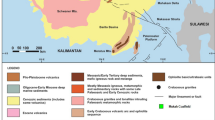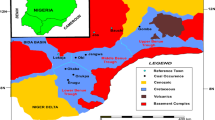Abstract
New Zealand coals range in age from Cretaceous to Miocene and represent a wide variety of mire floral communities. Chemical and petrographic analysis demonstrate considerable variability in coal properties, and particularly vitrinite chemistry. Although some chemical variability can be attributed to environmental controls such as mire drainage and marine influence, other trends correspond with age, climate and floral assemblage.
Mire flora is primarily reconstructed using palynological analysis. Cretaceous and Eocene coals are dominated by gymnosperm and angiosperm pollen respectively. Paleocene sequences exhibit large fluctuations in mire flora and provide ideal sample sets for investigation of potential floral controls on petroleum source potential.
Proximate analysis, specific energy, sulphur, palynology and Rock-Eval data presented for 36 coals demonstrate a general increase in petroleum source potential with increasing angiosperm palynomorph dominance. Notable exceptions are coals from immediately beneath the Cretaceous/Tertiary boundary at Greymouth Coalfield, which have moderate to high Rock-Eval yield despite very low angiosperm palynomorph abundance.
Pyrolysis-gcros of 3 Paleocene and 2 Cretaceous samples shows generally good oil generative potential, particularly for perhydrous coals. Stepwise pyrolysis-GCMS and bulk kinetic parameters indicate that angiosperm derived coals may generate oil at slightly lower temperatures than gymnosperm derived coals. This difference in generation temperatures is small, however there is evidence that current kinetic models do not account for rank variation in the immature analogues used to predict generation histories. Consequently, actual generation temperatures may be significantly underestimated, and the difference in generation temperatures for gymnosperm vs angiosperm derived coals may be more significant, than current models suggest.
Access this chapter
Tax calculation will be finalised at checkout
Purchases are for personal use only
Preview
Unable to display preview. Download preview PDF.
Similar content being viewed by others
References
Behar, F., Vandenbroucke, M., Tang, Y., Marquis, F. and Espitalié, J. (1997) Thermal cracking of kerogen in open and closed systems: determination of kinetic parameters and stoichiometric coefficients for oil and gas generation. Org. Ceochem. 26, 321–339.
Boreham, C.J. and Powell, T.G. (1993) Petroleum source rock potential of coal and associated sediments: qualititative and quantitiative aspects, in B.E.Law and D.D. Rice (eds.), Hydrocarbons from coals. AAPG Studies in Geology 38, 133–158.
Summons, R.E., Roksandic, Z., Dowling, L.M. and Hutton, A.C. (1994) Chemical, molecular and isotopic differentiation of organic facies in the Tertiary lacustrine Duaringa oil shale deposit, Queensland, Australia, Organic Geochemistry 21, 685–712.
Golding, S. and Glikson, M. (1997) Factors controlling gas generation and retention in Bowen
Basin coals, Australia, 18` h International Meeting on Organic Geochemistry, Maastricht, The Netherlands. Abstracts Part 1. Forschungszentrum, Julich, Germany, 41–42.
Golding, S.D. and Glikson, M. (1998) Factors controlling the origin of gas in Australian Bowen Basin coals. Org. Geochem. In press.
C.J., Horsfield, B. and Schenk, H.J. (in press) Predicting the quantities of oil and gas generated from Permian coals, Bowen Basin, Australia using pyrolytic methods, Marine and Petroleum Geology.
Bostick, N.H. and Daws, T.A. (1994) Relationships between data from rock-Eval pyrolysis and proximate, ultimate, petrographic and physical analysis of 142 diverse US coal samples. Org. Geochem. 21, 35–49.
Boudou, J.P., Espitalié, J., Bimer, J. and Salbut, P.D. (1994) Oxygen groups and oil suppression during coal pyrolysis. Energy and Fuels 8, 972–977.
Bumham, A.K. and Sweeney, J.J. (1989) A chemical kinetic model of vitrinite maturation and reflectance, Geochim. et Cosmochim. Acta 53, 2649–2657.
Collier, R.J. and Johnston, J.H. (1991) The identification of possible hydrocarbon source rocks, using biomarker geochemistry, in the Taranaki Basin, New Zealand, Journ. Southeast Asian Earth Sciences 5, 231–239.
Cook, R.A. (1987) The geology and geochemistry of crude oils and source rocks, New Zealand Geological Survey Petroleum Report 1250, Institute of Geological and Nuclear Sciences, Lower Hutt.
Czochanska, Z., Sheppard, C.M., Weston, R.J. and Woolhouse, A.D. (1987). A biological marker study of oils and sediments from the West Coast, South Island, New Zealand. New Zealand Journ. Geol. Geophys. 30, 1–17.
Gilbert, T.D., Philp, R.P., Sheppard, C.M., Weston, R.J., Wood, T.A. and Woolhouse, A.D. (1988) Geochemical application of sterane and triterpane biomarkers to a description of oils from the Taranaki Basin, New Zealand. Org. Geochem. 12, 123–135.
Daniel, I.L., Kennedy, E.M., Lovis, J.D., Moore, T.A., Newman, J., Shearer, J.C. and Wames, M.D. (1992) Reconstruction of terrestrial paleoclimate during the Cenozoic, using evidence from coal constituents, paleobotany, and palynology, Abstract,4`h Australia-New Zealand Climate Forum, Caims, Australia.
Durand, B. and Paratte, M. (1983) Oil potential of coals: a geochemical approach. In: Petroleum Geochemistry and Exploration of Europe, Geological Society Special Publication No. 12 (ed J. Brooks). Oxford, Blackwell Scientific Publications, 255–265.492 J. NEWMAN ET AL.
Horsfield, B. (1989) Practical criteria for classifying kerogens; some observations from pyrolysis-gas chromatography. Geochim. et Cosmochim. Ada 53, 891–901.
Killops, S.D., Raine, J.I., Woolhouse, A.D. and Weston, R.J. (1995) Chemostratigraphic evidence of higher-plant evolution in the Taranaki Basin, New Zealand, Organic Geochemistry 23, 429–445.
Moore, N. (1996) Seam identification, correlation and coal quality prediction using in-seam variations in key palynomorph abundances, Proceedings of the 1996 AusIMM (NZ Branch) Conference, Greymouth..
Murray, A.P., Sosrowidjojo, I.B., Alexander, R., Kagi, R.I., Norgate, C.M. and Summons, R.E. (1997) Oleananes in oils and sediments: Evidence of marine influence during early diagensis? Geochim. et Cosmochim. Acta 61, 1261–1276.
Newman, J. (1989) Why are some high rank Tertiary coals more peculiar then others? Some thoughts on climate and floral assemblage, Proceedings of 3“ Coal Research Conference, Wellington, New Zealand.(1991) Controls on the distribution, timing and effects of diagenetic sulphur enrichment on some New Zealand coals, Proceedings of 4` 1 Coal Research Conference, Wellington, New Zealand.
Newman, N.A. (1982) Reflectance anomalies in Pike River coals: evidene of variability in vitrinite type, with implications for maturation studies and “Suggate rank”, NZ Journ. Geol. Geophys 25, 233–243.
Price, L.C. and Johnston, J.H. (1997) Hydrocarbon source potential and maturation in Eocene
New Zealand vitrinite rich coals; Insights from traditional coal analyses, and Rock-Eval and biomarker studies, Journal of Petroleum Geology 20, 137–163.
Newman, N.A. (1987) High alumina ash West Coast coals. Proceedings of the 2n d Coal Research Conference, Wellington, New Zealand.
Saxby, J.D. (1982) A reassessment of the range of kerogen maturities in which hydrocarbons are generated J Petroleum Geol 5 117–128.
Schenk, H.J., Horsfield, B., Krooss, B., Schaefer, R.G. and Schwochau, K. (1996) Kinetics of petroleum formation and cracking, in D.H. Weite, D.R. Baker and B.Horsfield (eds.), Petroleum and Basin Evolution, Springer Verlag, Heidelberg, pp 231–269.
Shearer, J.C. and Moore, T.A. (1994a) Grain size and botanical analysis of two coal beds from the South Island of New Zealand, Paleogeog., Paleoclim., Paleoecol. 80, 85–114.
b) Botanical control on banding character in two New Zealand coal beds, Paleogeog., paleoclim., Paleoecol 110 11–28.
Suggate, R.P. (1959) New Zealand coals; their geological setting and its influence on their properties, New Zealand Dept of Sci. and Ind. Res. Bull 134.and Boudou, J.P. (1993) Coal rank and type variation in Rock-Eval assessment of New Zealand coals. Journ. Petrol. Geol. 16, 73–88.
Sweeney, J.J. (1990) Basinmat: Fortran program calculates oil and gas generation using a distribution of activation energies. Geobyte April 37–43.
Sykes, R.P., Suggate, R.P. and King, P.R. (1993) Timing and depth of maturation in southern Taranaki Basin from reflectance and rank (S). Proceedings of the New Zealand Petroleum Symposium, Christchurch, 373–389.
Tang, Y. and Stauffer,’ M. (1994) Multiple cold trap pyrolysis gas chromatography: a new technique for modelling hydrocarbon gnereation, in N. Telnaes, G. van Grass and K. Oygard (eds.) Advances in Organic Geochemistry 1993, Organic Geochemistry 22, 863–872.
Teichmuller, M. and Durand, B. (1983) Fluorescence microscopical rank studies on liptinites and vitrinites in peat and coals, and comparison with results of the Rock-Eval pyrolysis. Int. Journ. Coal Geol. 2, 197230.
Traverse, A. (1988) Paleopalynology, Unwin-Hyman, Boston.
Ungerer, P. (1990) State of the art in kinetic modeling of oil formation and expulsion, Organic Geochemistry 16, 1–25.
Warnes, M.D. (1992) Interpretations of coal forming vegetation of the Morley Coal Measures, Ohai Coalfield, Geological Society of New Zealand miscellaneous publication 63a:
Ward, S.D., Moore, T.A. and Newman, J. (1995) Floral assemblage of the “D” coal seam (Cretaceous): implications for banding characteristics in New Zealand coal seams, N Z Journ. of Geol. and Geophys. 38, 283–297.
Author information
Authors and Affiliations
Editor information
Editors and Affiliations
Rights and permissions
Copyright information
© 1999 Springer Science+Business Media Dordrecht
About this chapter
Cite this chapter
Newman, J., Boreham, C.J., Ward, S.D., Murray, A.P., Bal, A.A. (1999). Floral Influences on the Petroleum Source Potential of New Zealand Coals. In: Mastalerz, M., Glikson, M., Golding, S.D. (eds) Coalbed Methane: Scientific, Environmental and Economic Evaluation. Springer, Dordrecht. https://doi.org/10.1007/978-94-017-1062-6_28
Download citation
DOI: https://doi.org/10.1007/978-94-017-1062-6_28
Publisher Name: Springer, Dordrecht
Print ISBN: 978-90-481-5217-9
Online ISBN: 978-94-017-1062-6
eBook Packages: Springer Book Archive




